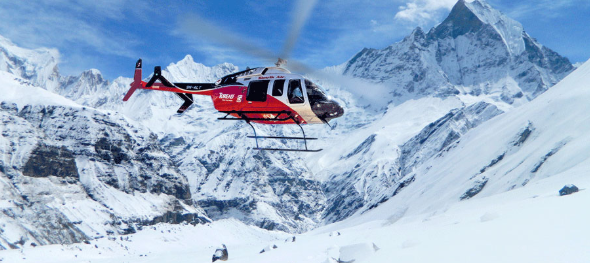The Everest Base Camp Helicopter Tour offers an exhilarating alternative to the traditional trek, allowing adventurers to experience the majesty of Mount Everest—the world’s highest peak at 8,848 meters—without the multi-day hike. Departing from Kathmandu, this aerial journey soars over Nepal’s Khumbu region in Sagarmatha National Park, a UNESCO World Heritage Site, providing panoramic views of snow-capped giants like Lhotse, Nuptse, Ama Dablam, and the Khumbu Glacier. Ideal for those with limited time, physical constraints, or a preference for luxury, the tour typically lasts 4-5 hours, combining scenic flights with strategic landings for photos and immersion. In 2025, with enhanced safety protocols and sustainable practices amid growing tourism, it’s more accessible than ever, attracting families, seniors, photographers, and thrill-seekers. Unlike the 12-14 day trek covering 130 kilometers, this tour delivers the essence of Everest in a single day, starting with a thrilling takeoff from Tribhuvan International Airport. Best seasons remain spring (March-May) for blooming rhododendrons and clear skies, or autumn (September-November) for stable weather and post-monsoon visibility, avoiding the risks of monsoon rains or winter snows.
Preparing for the Tour
Preparation ensures a safe and enjoyable experience, focusing on health, packing, and logistics rather than intense physical training. Start by consulting a doctor, especially if you have heart, lung, or altitude-related concerns, as rapid ascents to over 5,000 meters can trigger Acute Mountain Sickness (AMS) symptoms like headaches, nausea, or dizziness. While less demanding than trekking, acclimatization is key—stay hydrated (3-4 liters daily), avoid alcohol and caffeine 24 hours prior, and consider preventive medications like Diamox if recommended. Book with reputable operators like Adventure Master Trek, Nepal Trekking Routes, or Adventure Club Trek, which provide experienced pilots, well-maintained helicopters (e.g., AS350 B3E models), and emergency oxygen.
Packing is minimal due to weight limits (typically 450 kg total for 5 passengers, reducing at higher altitudes). Opt for layers: thermal base layers, fleece mid-layers, a down jacket, windproof pants, gloves, a woolen hat, and sturdy shoes for brief walks on uneven terrain. Essentials include UV-protective sunglasses, sunscreen, lip balm, a reusable water bottle, energy snacks, personal medications, a camera with extra batteries, and a small daypack. Documents needed: passport copies, travel insurance covering high-altitude evacuation (mandatory), and permits like the Sagarmatha National Park Entry Permit ($30/person) and Khumbu Pasang Lhamu Rural Municipality tax, often handled by operators. Arrive at your Kathmandu hotel the night before; tours include hotel-to-airport transfers. Book 2-4 weeks in advance for peak seasons to secure spots and discounts.
Detailed Itinerary
A standard 2025 Everest Base Camp Helicopter Tour is a round-trip from Kathmandu, adaptable for private or shared groups. It begins early to maximize clear weather, with flexibility for delays.
- Pre-Departure (5-6 AM): Pickup from your Kathmandu hotel and transfer to Tribhuvan International Airport’s domestic helipad (20-30 minutes). Check-in involves security, weighing (for balance), passport verification, and a safety briefing on boarding, seatbelts, and emergency procedures.
- Takeoff to Lukla (6-7 AM): Board the helicopter (up to 5 passengers plus pilot) and depart, flying over Kathmandu’s hills, terraced fields, and into the Himalayas. Land at Lukla’s Tenzing-Hillary Airport (2,846m) after 30-45 minutes for refueling and brief acclimatization (15-20 minutes), offering views of Sherpa villages.
- Lukla to Pheriche/Khumbu (7-8 AM): Ascend to Pheriche (4,371m), passing over the Dudh Koshi River, monasteries, and Namche Bazaar. Here, groups may split if exceeding weight limits for higher altitudes (up to 5 can land).
- Over Everest Base Camp to Kala Patthar (8-9 AM): Overfly Everest Base Camp (5,364m) and the Khumbu Glacier for aerial glimpses of tents and icefalls. Land at Kala Patthar (5,545m-5,644m) for 10 minutes (2 passengers at a time due to 220 kg limit), capturing 360-degree panoramas of Everest, Lhotse, and Nuptse—often the tour’s highlight.
- Kala Patthar to Everest View Hotel (9-10 AM): Descend to Syangboche and land at the Everest View Hotel (3,880m, world’s highest hotel) for 30-60 minutes. Enjoy a luxurious breakfast with Everest vistas, mingling with fellow travelers.
- Return to Kathmandu (10 AM-Noon): Fly back, possibly refueling at Lukla, arriving by midday. Transfer to your hotel, concluding the adventure.
Variations include private charters for customized stops, or hybrid tours like the 10-day Everest Trek with Helicopter Return, blending hiking to EBC with a heli ride back. Total flight time: 3-4 hours, with pilots narrating landmarks.
Challenges and Safety Tips
While luxurious, challenges include weather dependency—fog, winds, or rain can delay or cancel flights, requiring flexibility (operators offer refunds or rescheduling). Altitude sickness is a risk from quick ascents; symptoms appear rapidly, so monitor for headaches or breathlessness and use onboard oxygen if needed. Weight restrictions limit passengers at high points, potentially requiring shuttle flights.
Safety is paramount: Choose operators with experienced pilots trained in Himalayan conditions and helicopters undergoing regular inspections. Tips: Follow briefings (approach from front, secure items), stay seated, hydrate pre-flight, wear layers for temperature drops (freezing at landings), and avoid heavy meals. No direct EBC landing due to glacial instability—overfly only for safety. For families or seniors, it’s suitable with precautions; children and elderly can participate if healthy. Practice responsible tourism: Minimize plastics, respect Sherpa culture with “Namaste,” and support local economies.
Costs in 2025
Budget $1,000-$1,500 per person for shared group tours (4-5 people), dropping to $1,100-$1,150 with discounts for larger groups. Private charters range $4,000-$6,000 total, offering flexibility. Inclusions: Flights, transfers, permits ($50-80 covering taxes and entry), breakfast, and oxygen. Extras: Insurance ($100-200), tips ($20-50), personal snacks, or additional shuttles. Off-season savings possible, but peak times command premiums—book early via operator websites.
Conclusion
The Everest Base Camp Helicopter Tour in 2025 transforms an epic adventure into an accessible luxury, blending breathtaking aerial perspectives with cultural glimpses and personal triumph. Returning with memories of soaring over glaciers and gazing at Everest from Kala Patthar, you’ll appreciate the Himalayas’ grandeur without the trek’s rigors. Plan responsibly, fly safely, and embrace this sky-high journey—it’s a testament to human ingenuity and nature’s awe.

